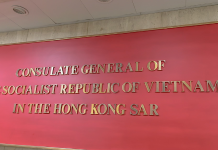Apart from JetOne, there are also studios in Hong Kong specialising in content development for VR. Creote Studio is a company providing digital design services based in Wong Chuk Hang. Roy Lo, the 34-year-old business director, says commercial applications of VR can be divided into training and simulation, and reality experience. In Creote Studio’s previous project with the Hongkong Electric Company, Lo says they used 3D modelling to reproduce construction sites from the real world for workers’ training.
“There are many health and safety compliances to meet on a construction site, but talking about them using stacks of handouts in lessons is really boring,” Lo says. “Using a VR training software will be a more interactive way [to do it].”

As for reality experience, Lo gives the example of a testing laboratory exhibition in Barcelona. The exhibition used VR to offer virtual tours of a laboratory located in Taiwan. There were interactive elements that allowed users to walk through different rooms and learn about the Taiwanese laboratory in Barcelona. Lo says VR technology enabled people to overcome geographical barriers and get a clearer understanding of the laboratory’s operations.
Like Noel Leung, Lo says he has noticed more corporations are now willing to invest in VR. He attributes this to big campaigns and promotions carried out in the past year by major companies such as Samsung.
“Interested parties are starting to consider the budgets and resources to invest,” Lo says. “We see more and more corporations have the determination to adopt VR in their businesses.”
Despite the optimism in the market, Hong Kong may still be a bit behind when it comes to the development of VR. There are various reasons for this, which apply to both the gaming and content development markets. Edward Cheung Kwan-king, a principal reporter at unwire.hk, a website reporting on tech, says there is an overall lack of VR content.
Cheung explains one of the reasons is that filming, producing and even live broadcasting VR content is very expensive. So many companies stick to using traditional methods of producing content like videos. He notes a problem specific to Hong Kong is that although there are a lot of VR devices like HTC Vive, Samsung Gear 360 and LG 360 Cam available, few people shoot their own VR videos. He says many people in Hong Kong still prefer to view online productions that approximate VR.
Aqua Tsang Tsz-chung, a reporter and Cheung’s colleague at unwire.hk, says another problem that has plagued the development of VR technology is VR-induced motion sickness, commonly referred to as virtual reality sickness. Tsang recalls feeling dizzy after playing the game Resident Evil 7 for 45 minutes using a VR headset.
It is not known exactly what causes virtual reality sickness but one theory is that there is a mismatch between the refresh rate of the screen and how quickly the brain can process images. The refresh rate often cannot keep up with the brain .“It is not a problem of quality, but frame rate,” says Tsang.
Richard So Hau-yue, a professor from the Department of Industrial Engineering and Logistics Management at the Hong Kong University of Science and Technology, says only half of the human population are prone to motion sickness in a virtual environment. So says the more realistic virtual images are, the more likely they are to induce an illusion of self motion that makes people sick.






































